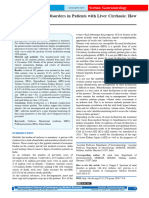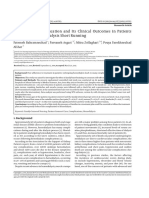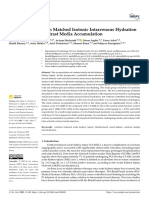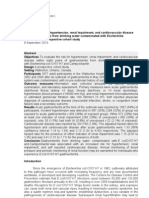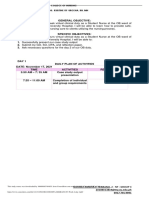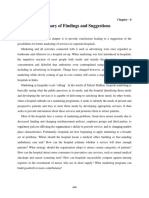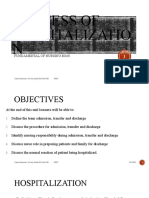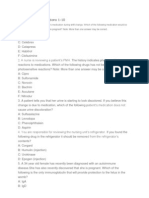Assessing N Documenting Fluid Balance
Assessing N Documenting Fluid Balance
Uploaded by
Winda Ayu SholikhahCopyright:
Available Formats
Assessing N Documenting Fluid Balance
Assessing N Documenting Fluid Balance
Uploaded by
Winda Ayu SholikhahOriginal Description:
Original Title
Copyright
Available Formats
Share this document
Did you find this document useful?
Is this content inappropriate?
Copyright:
Available Formats
Assessing N Documenting Fluid Balance
Assessing N Documenting Fluid Balance
Uploaded by
Winda Ayu SholikhahCopyright:
Available Formats
evidence & practice / hydration
ASSESSMENT
Assessing and documenting fluid balance
Pinnington S, Ingleby S, Hanumapura P et al (2016) Assessing and documenting fluid balance. Nursing Standard. 31, 15, 46-54.
Date of submission: 28 January 2016; date of acceptance: 19 April 2016. doi: 10.7748/ns.2016.e10432
Sarah Pinnington Abstract
Acute care clinical Concerns about inadequate patient hydration and suboptimal monitoring of fluid balance
educator, Manchester have been documented in recent reports. The Fluid Balance Improvement Project at Central
Royal Infirmary, Central Manchester University Hospitals NHS Foundation Trust was undertaken to identify risk
Manchester University factors influencing hydration and to implement a revised process to manage these risks,
Hospitals NHS Foundation resulting in the development of a hydration pathway. This new approach to monitoring
Trust, Manchester, patient hydration, together with staff education and support, has resulted in improved
England compliance with fluid balance monitoring standards, as well as significant improvements
in identifying patients at risk of dehydration, and an increase in patients with acute kidney
Sarah Ingleby injury commencing appropriate fluid balance monitoring.
Lead nurse, acute care
and hospital at night, Keywords
Central Manchester acute kidney injury, fluid balance, fluid balance assessment, hydration, hydration
University Hospitals assessment, renal care, service improvement
NHS Foundation Trust,
Manchester, England
WATER MAKES UP an average of 60% Acutely Ill Adults in Hospital: Recognising
Prasanna Hanumapura of total body mass in adult males and an and Responding to Deterioration. Timely and
Acute kidney injury average of 50-55% of total body mass in appropriate use of fluid balance observations
specialist nurse, Central adult females (European Food Safety Agency is essential in determining adequate
Manchester University Panel on Dietetic Products, Nutrition, and hydration (Scales and Pilsworth 2008). When
Hospitals NHS Foundation Allergies 2010). Water is necessary for patients are acutely ill, or have the potential
Trust, Manchester, various essential processes in the body; to become acutely ill, they may show early
England therefore, an adequate fluid balance is warning signs that can be identified by
fundamental to maintaining metabolic accurate fluid balance measurement and
Deryn Waring processes (Welch 2010). Alterations to the documentation. A declining urine output may
Acute kidney injury fluid volume and subsequent changes to the indicate initial signs of renal dysfunction,
specialist nurse, Central bodys electrolyte levels resulting from fluid while a reduction in fluid intake may indicate
Manchester University imbalance can have serious consequences. issues such as changes in consciousness
Hospitals NHS Foundation Mild to moderate dehydration may lead to level, gastrointestinal problems or general
Trust, Manchester, physical and mental deterioration, while ill health. In the absence of appropriate and
England severe dehydration, where there is a decrease accurate fluid balance monitoring, these signs
of more than 15-20% total body fluid, may not be recognised, contributing to an
Correspondence can be fatal (Madden 2000). By contrast, increased length of stay in hospital and, in
sarah.pinnington@cmft. fluid overload occurs when there is an some cases, death (NICE 2007, Grams et al
nhs.uk excessive circulating volume. This manifests 2011).
as pulmonary oedema and peripheral Problems persist with monitoring fluid
Conflict of interest oedema, and can cause acute deterioration, balance and ensuring patients are adequately
None declared affecting patient outcomes and mortality hydrated, despite clinical guidance and
(Bouchard et al 2009). evidence that demonstrate the importance
Accurate monitoring of a patients fluid of monitoring fluid balance in patient care.
balance status is an essential component of Cases of dehydration in hospitals have
the National Institute for Health and Care been reported in the national press (Sky
Excellence (NICE) (2007) clinical guideline, News 2013, Disley 2014), bringing this
46 / 7 December 2016 / volume 31 number 15 nursingstandard.com
issue to public attention. Despite national Acute kidney injury Peer review
initiatives intended to improve hydration Development of acute kidney injury is closely This article has been
in healthcare settings (Royal College of linked to suboptimal fluid management. subject to external
Nursing (RCN) et al 2007), there is limited Acute kidney injuryresults from a rapid double-blind peer
evidence of success in preventing suboptimal deterioration ofrenalfunction, leading to review and checked
recognition and response to fluid balance an inability to maintain fluid, electrolyte and for plagiarism using
concerns. The causes of inadequate hydration acid-base balance (Bellomo et al 2012). The automated software
and failure to monitor fluid balance are causes of acute kidney injury can be divided
complex, with multiple influences. The into three categories: Online
Care Quality Commission (2011) identified Pre-renal, caused by reduced perfusion. For related articles visit
central themes when discussing the dignity Intrinsic renal, caused by damage to the the archive and search
and nutrition inspection programme, because kidney. using the keywords.
there was concern that patients were not Post-renal, caused by obstruction in the Guidelines on writing for
receiving sufficient fluids. These themes drainage of urine. publication are available
included: the difficulty patients experienced The causes of injury in each category, with at: journals.rcni.com/r/
obtaining fluids; inadequate monitoring of the most common cause of injury listed author-guidelines
food and fluid intake; and lack of adequate first, are shown in Box 1.
assistance if a patient needed help with eating Pre-renal causes account for approximately
or drinking. Using a variety of measures, 70% of acute kidney injury cases in the
including a survey, knowledge quiz and community, and for up to 60% of inpatient
observation, Reid et al (2004) found that the cases (Godin et al 2013). Hypoperfusion
absence of appropriate training and a lack of resulting from volume depletion, reduced
understanding of daily fluid input and output cardiac output and hypotension all lead to a
targets affected the recognition of hydration reduction in renal perfusion pressure. Renal
issues and compliance with accurate hypoperfusion reduces glomerular capillary
monitoring in healthcare staff. Therefore, pressure and the glomerular filtration rate,
hydration and fluid monitoring should be while prolonged hypoperfusion contributes
prioritised in healthcare settings, to prevent to the development of acute tubular necrosis
unnecessary harm to patients. (Harty 2014). Pre-renal causes of acute
kidney injury relate to circulatory volume
Context of the Fluid Balance insufficiency, emphasising the importance
Improvement Project
The Fluid Balance Improvement Project BOX 1. Causes of acute kidney injury
was undertaken at Central Manchester
University Hospitals NHS Foundation Trust Pre-renal:
in 2015. Anecdotal evidence had suggested Hypovolaemia, for example bleeding, gastrointestinal
losses
that compliance with the organisations Sepsis
fluid balance policy was suboptimal. Cardiac arrhythmias
Four small-scale audits of documentation Myocardial infarction
between August 2014 and October 2014 Renal artery stenosis
indicated that compliance with accurate Intrinsic renal:
recording of fluid balance was inconsistent Prolonged hypoperfusion, causing tubular injury
and that inconsistencies were also evident Interstitial nephritis
Nephrotoxins
in the escalation of hydration concerns Infiltrative disease, for example myeloma
by healthcare staff. The organisations Glomerulonephritis
professional practice forum made the Rhabdomyolysis
decision to review the hydration pathway Post-renal:
and identify issues affecting consistent Renal stone disease
implementation. Various information sources Blocked catheter
were analysed to scope the issues relating to Prostatic hypertrophy, prostate cancer
Urethral stricture
hydration and monitoring of fluid balance in Pelvic masses, for example cervical cancer
the Central Manchester University Hospitals
(Adapted from The Royal College of Physicians of Edinburgh 2013)
NHS Foundation Trust.
nursingstandard.com volume 31 number 15 / 7 December 2016 / 47
evidence & practice / hydration
KEY POINT of accurate and responsive fluid balance fluid balance monitoring and the escalation
A clinical diagnosis of management to enable early recognition of of hydration concerns in accordance with
acute kidney injury can be deterioration (Bellomo et al 2012). local policy, using the policy standards
established by the onset of The presentation of acute kidney injury to measure compliance. All of the audits
oliguria; anuria (urine output will depend on the underlying cause. There demonstrated a lack of awareness of fluid
of less than 100mL per day); may be no signs or symptoms. However, balance policy, and there was 30% (72/242)
or deteriorating creatinine oliguria (urine volume of less than 0.5mL/ overall compliance with chart completion
levels (Rahman et al 2012). kg/hour), is common (NICE 2013). A and accurate recording and documentation
If acute kidney injury is not clinical diagnosis of acute kidney injury of fluid balance. Where concerns were
recognised and not treated can be established by the onset of oliguria; identified about the patients fluid balance,
in a timely manner, further anuria (urine output of less than 100mL there was no escalation in most cases. Non-
deterioration results in the per day); or deteriorating creatinine levels compliance with the fluid balance policy in
development of uraemia, (Rahman et al 2012). If acute kidney adult inpatient areas and inadequacies in
acidosis and hyperkalaemia, injury is not recognised and not treated monitoring standards increased the risk of
which can be fatal in a timely manner, further deterioration non-recognition and suboptimal response to
(NICE 2013) results in the development of uraemia, the deteriorating adult, and heightened the
acidosis and hyperkalaemia, which can possibility of mismanagement.
be fatal (NICE 2013). In 2009 the report, An electronic fluid balance monitoring
Acute Kidney Injury: Adding Insult to system was available in Patientrack,
Injury, carried out National Confidential the electronic observation and alerting
Enquiry into Patients Outcomes and system that had been used throughout the
Death identified significant deficiencies in organisation to record clinical observations
the recognition and management of acute since 2009. Electronic documentation in
kidney injury; suboptimal fluid balance Patientrack enables accurate calculations of
monitoring was a recurring issue. fluid balance and automated reminders to
Data analysis at Central Manchester undertake assessment. It is also possible to
University Hospitals NHS Foundation Trust use alerts to automatically contact relevant
in 2014 concluded that approximately one healthcare staff in response to an elevated
in four acute patients (25% (185/745)) had Central Manchester University Hospitals
clinical indications of acute kidney injury, NHS Foundation Trust Early Warning
with sepsis and dehydration being the most Score, where necessary.
common causes (Challiner et al 2014). However, the authors identified that
This equates to 4,000 new cases of acute improvements were required in the current
kidney injury per year in the organisation. process and that it was necessary to
A retrospective unpublished study of 745 investigate the reasons acute kidney injury
patient case notes undertaken in 2014 by was occurring before the implementation
the acute kidney injury specialist team of the new electronic system, which could
found that dehydration accounted for 35% compound existing risks if these were
(260/745) of patients with acute kidney not addressed. It was vital to improve the
injury. Development of acute kidney injury hydration assessment process to: ensure
resulted in a threefold-increase in the length compliance with accurate and responsive
of hospital stay. It also increased the number fluid balance monitoring in adult inpatient
of critical care bed days and patient mortality areas; improve patient safety; and enable
in the organisation. The study identified that early recognition of acutely unwell patients.
fluid balance charts had not been maintained
for around 50% of acute kidney injury cases, Fluid Balance Improvement Project
leading to delays in recognising inadequate The Fluid Balance Improvement Project team
urine output and the risk of dehydration. was established to undertake a programme of
Between November 2014 and December improvement work in relation to how nurses
2014, audits of fluid balance charts were assess and record fluid balance in clinical
undertaken in 20 inpatient wards in the care. The main objective was to ensure the
adult divisions within the organisation to safe assessment and management of patients
assess healthcare staff compliance with at risk of fluid balance abnormalities,
48 / 7 December 2016 / volume 31 number 15 nursingstandard.com
ensuring that fluid balance monitoring The authors review of the fluid balance
was completed consistently and that any policy confirmed there were gaps in the
abnormalities were identified and responded guidance provided and the procedures for
to in a timely manner. The improvement escalation were complicated, demonstrating
work involved reviewing practice and the necessity to change existing practice.
ensuring this was evidence based and in Hierarchical task analysis is a structured,
accordance with relevant policies. Quality objective approach that provides an
improvement methodology was used to understanding of the tasksthat users should
support the process. Safety in the process perform to achieve certain goals (Embrey
was ascertained by using the Safer Clinical 2000). The use of hierarchical task analysis
Systems approach developed by The Health enabled the fluid balance pathway to be
Foundation (2009). Four plan, design, broken down into progressively smaller
study, act (PDSA) cycles (NHS Institute for component tasks that were required
Innovation and Improvement 2010) were to complete the pathway. This method
used to develop and implement various identifies any unnecessary tasks, steps or
agreed changes and to evaluate the effects potential errors that might occur when
of the changes made in the identified clinical performing each task, which enables the
areas. This process will be discussed later in user to identify areas of the pathway that
this article. require improvement.
It was also important to consult clinical
Reviewing the process staff in the change process. Bevan (2010)
The Health Foundation (2009) Safer Clinical
Systems tools were initially used in Central
Figure 1. Process map of fluid balance pathway with identified areas of risk
Manchester University Hospitals NHS
Foundation Trust in 2009, working with
Warwick University to test the methodology.
Patient admitted
These tools were used to review pathways
and to assess, measure and ensure safety
throughout the pathway. This approach was
used at the start of the project in January Nurse decides if fluid balance
Risk: No assessment tool
2015 to identify areas of risk in the process available. At risk patients may be
chart is required
missed.
of fluid balance monitoring and to develop
interventions that address or mitigate these
hazards to reduce high-level risks. Process Risk: Chart started on incorrect patient,
mapping identified the pathway as well as Commence fluid balance chart
or chart not commenced at all.
areas of risk and the potential for failure at
all points in the fluid balance monitoring
Risk: No communication occurs or
process (Figure 1). communication is ineffective.
Inform team that patient requires
Failure mode and effect analysis (Kelly fluid balance monitoring Team not aware of need for fluid
2011) was used to systematically analyse balance monitoring.
each stage of the patient journey, addressing
any risk identified. This enabled the review Risk: Not accurately completed or not
of current practice and the calculation Complete fluid balance chart completed at all.
of the probability and severity of each
identified area of risk on the trust risk
Risk: Lack of understanding and
matrix. This measured the effect or severity recognition of fluid balance issues.
and likelihood of each risk identified. The Escalate issues of concern Complicated escalation process.
severity, likelihood and risk score can be relating to fluid balance
used to evaluate the overall level of the risk
as very low, low, medium or high. High Risk: No guidance for discontinuation.
and medium-risk scores were associated No risk patients or patients no longer at
Discontinue fluid balance chart risk left on charts increasing workload
with the identified areas of risk; assessment, unnecessarily.
documentation and escalation scored highest.
nursingstandard.com volume 31 number 15 / 7 December 2016 / 49
evidence & practice / hydration
emphasised that if clinical staff are engaged ensure fluid balance was completed accurately
with the process, they are often ideal to and comprehensively. Documentation from
identify and support change, increasing the Bedford Hospital NHS Trust provided a
likelihood of its sustainability. Workshops workable basis for what the authors aimed
and focus groups were held with healthcare to achieve and they were given permission to
staff involved in fluid balance monitoring, to adapt this for the pathway. The documentation
ascertain the problems with existing practice bundle included the use of a daily hydration
and to ask for ideas for the improvement assessment tool and the use of a hydration
project. These confirmed there was a lack chart alongside fluid balance charts. The
of ownership of and accountability in project team adapted this approach and
completing fluid balance charts, resulting in developed the new hydration pathway
non-compliance with local documentation (Figure 2) and supporting documentation.
standards and the failure to monitor patients
hydration status accurately.Many of the Hydration pathway
healthcare professionals did not know documentation bundle
the correct indications for fluid balance The new hydration pathway consists of a
monitoring. This could result in some daily hydration assessment and a choice of
at-risk patients being overlooked for fluid two monitoring charts: the hydration chart
balance monitoring, increasing the risk of and the fluid balance chart.
harm, while 56 patients without any risk
factors that could influence hydration were Hydration assessment
monitored in the initial audits, increasing The implementation of a hydration
healthcare staff workload unnecessarily. assessment (Figure 3) enabled patients to be
The predominance of patients undergoing assessed for factors influencing hydration and
fluid balance monitoring unnecessarily ensured that at-risk patients were correctly
reduced awareness of the vital role that identified and monitored accordingly. The
comprehensive fluid balance monitoring can introduction of this assessment tool removed
have in recognising patient deterioration. the possibility of at-risk patients being put at
The review process identified that unnecessary risk of harm by not monitoring
assessment of patient fluid balance status their fluid balance.
and the documentation available for fluid
balance monitoring were inadequate to Hydration chart
The hydration chart (available as Figure 4
Figure 2. Hydration pathway online) is a simple-to-use chart for patients
who do not require strict fluid balance
Patient admitted to ward monitoring, but who have one or more low-
risk factors that could influence hydration,
Hydration assessment within 6 hours corresponding to the yellow section of
the hydration assessment form. Regular
assessment at intervals throughout the day
Fluid balance chart Hydration chart No monitoring enables early escalation of potential issues.
Fluid balance chart
Nurse-signed review The fluid balance chart is for patients who
Nurse-signed review
every 6 hours. 24-hour signed
3 times a day. require strict fluid balance monitoring
review by nurse or doctor.
(available as Figure 5 online), who have
one or more high-risk factors that could
Any concerns escalate to Any concerns escalate to influence hydration, corresponding to the
the nurse in charge and the nurse in charge.
red section of the hydration assessment
medical team. Reassess need for
fluid balance chart. form. The fluid balance chart includes
an area for documentation of special
Daily hydration assessment until discharge (unless variance documented).
instructions, consideration of insensible
loss and for 24-hour review of fluid balance
50 / 7 December 2016 / volume 31 number 15 nursingstandard.com
Figure 3. Hydration assessment
Name: Integrated care pathway
Chart
Hospital number:
of
Date of birth: Ward: . Hydration assessment
All inpatients at the trust should be assessed by a nurse only for hydration status within 6 hours of admission.
All patients should be reviewed at least once a day before 10am or when their condition changes to assess if a hydration chart, a fluid balance chart or no
monitoring is required.
Please only Tick appropriate factors. If the patient has factors in both the red and yellow sections, commence a fluid balance chart.
Factors influencing hydration: any of the following: Date Date Date Date Date Date Date
Acute kidney injury and/or sudden decrease in urine output
(<0.5mL/kg/hour)
Commence a 24-hour fluid balance chart
Sepsis
Intravenous fluids, nasogastric or percutaneous
endoscopic gastrostomy feed or total parenteral nutrition
Diarrhoea or high stoma output
Patient less than 48 hours postoperatively (excluding day case)
Nil-by-mouth status
Fluid restriction (exclude long-term restrictions, for example, dialysis)
Chemotherapy
High-drainage wounds
Increased vomiting or high nasogastric output
Short-term catheter or catheter removed less than 24-hours ago
Request by clinical team
Dry mucous membranes, dry lips, skin turgor, sunken eyes
Decreased or restricted mobility
Difficulty handling cups or cutlery, or unable to pour their own
drinks?
Commence hydration chart
Age >75 years
Diuretics
Diabetes
Delirium and/or dementia
Constipation
Febrile patients (temperature >38C)
Decreased appetite
Consuming clear or free fluids only
Urine colour score above 3
Long-term catheter
None of the above risk factors
No monitoring
Medically fit patients awaiting discharge
required
Daily weights deemed appropriate for monitoring hydration
Monitoring not required after discussion with medical staff and/or
nurse in charge
Signature:
Print name:
nursingstandard.com volume 31 number 15 / 7 December 2016 / 51
evidence & practice / hydration
KEY POINT chart by the nursing or medical team. and review the effects of the change before
Quality improvement deciding how to proceed or modify the
methodology was used Patient involvement intervention (NHS Institute for Innovation
to trial the new hydration To support the new hydration pathway and Improvement 2010). Using PDSA cycles,
pathway in three ward and to encourage patient involvement, the authors were able to assess the effect of
areas. These wards were urine colour chart posters were displayed in the hydration pathway, enable modifications
chosen for their mix of patient bathrooms and sluice areas (available and identify elements that they had not
patient acuity and high as Figure 6 online), to serve as a guide to considered in the initial development of the
turnover of patients, to indicate whether a patient is adequately pathway. This led to further cycles, which
help demonstrate whether hydrated based on the colour of their urine. considered documentation revision and
the new documentation A patient information leaflet explains why educational needs analysis for all grades
was workable. Audits to it is necessary to monitor fluid balance, of healthcare staff. Following four PDSA
measure the compliance, provides information about how to keep cycles, the audits demonstrated a significant
accuracy and escalation of hydrated and encourages patient involvement increase in compliance with fluid balance
monitoring were conducted in fluid balance monitoring, where they are policy standards to 92% (55/60 charts
in all three areas before the able (available as Figure 7 online). completed correctly) and a significant
pilot trial. This provided a While the development stage of the project increase in the recognition and escalation of
baseline measure by which did not engage patient groups as partners hydration issues. This was reflected in the
improvements or shortfalls in the process, the hydration pathway improvement in patients with acute kidney
in hydration management documentation was developed in response injury beginning appropriate fluid balance
could be shown, following to healthcare professionals feedback and monitoring in the trial areas from 2/10
implementation of the requirements, and their feedback in the initial (20%) patients in the initial pre-trial audit to
hydration pathway documentation trial identified that changes 10/11 (91%) patients in the post-trial audit,
were required to the documentation to enable following implementation of the hydration
patient participation in the improvement pathway. This had a positive effect on
project. In retrospect, the inclusion of acute kidney injury management standards,
patient representation from the beginning resulting in an ongoing reduction in the
of the project would have been beneficial. length of stay of patients with acute kidney
Close links have since been established with injury in the trial areas.
patient experience groups to improve patient
participation and education. Implementation
The resulting improvement in patient
Pilot trial safety following the pilot trial led to the
Quality improvement methodology was used implementation of the hydration pathway
to trial the new hydration pathway in three throughout adult inpatient areas in Central
ward areas. These wards were chosen for Manchester University Hospitals NHS
their mix of patient acuity and high turnover Foundation Trust. The hydration pathway
of patients, to help demonstrate whether the was not deemed suitable for obstetric
new documentation was workable. Audits areas, because the majority of patients
to measure the compliance, accuracy and in this group are healthy. However, fluid
escalation of monitoring were conducted balance charts from the hydration pathway
in all three areas before the pilot trial. This are used if an obstetric patient requires
provided a baseline measure by which fluid balance monitoring, ensuring that
improvements or shortfalls in hydration regular reviews are undertaken over a 24-
management could be shown, following hour period to enable early recognition and
implementation of the hydration pathway. escalation of hydration issues.
The initial audits demonstrated 32% Forty wards were included in the
compliance with fluid balance monitoring introduction of the hydration pathway and
standards (19/60 charts completed correctly), documentation. While the project team was
with 15 delays in escalation of concerns involved in staff education and producing
related to fluid balance. teaching materials, divisional educators
The PDSA cycle is a method that helps to were asked to support the introduction
plan an intervention, test it on a small scale of the pathway in their ward areas. The
52 / 7 December 2016 / volume 31 number 15 nursingstandard.com
implementation took longer than initially status have received formal training. Junior KEY POINT
anticipated, taking 6 months instead of 2-3 doctors have requested further training on The project team aim
months, because of the competing demands hydration risks, fluid balance interpretation to develop education
of other mandatory training needs and and fluid management, using staff tools that can be used in
local priorities. Compliance has been feedback. This training is included in their community, preoperative
monitored through audits by the project weekly teaching programme. and outpatient settings
team, and by including questions relating Staff education is vital to help reduce the to increase awareness of
to the hydration pathway in the care risk of suboptimal hydration and to improve the necessity of adequate
quality rounds completed monthly by ward the recognition of fluid balance issues. It is hydration. This may help
teams. Monitoring has shown consistent also important to educate patients and the to reduce the number
compliance of more than 80% with the general public to empower them, ensure of patients presenting
organisations standards. ownership of hydration issues and enable a with conditions related to
The hydration pathway was not integrated move towards self-care or towards a shared dehydration, such as acute
immediately during the introduction period. approach to healthcare. Several community kidney injury, urinary tract
However, the project team were able to settings have begun to display urine colour infections and pressure
identify this through staff feedback and charts (available as Figure 6 online). The ulcers (RCN et al 2007).
audits of compliance, and were able to project team aim to develop education tools Targeted education for
respond to difficulties with implementation that can be used in community, preoperative the public combined with
in a timely manner. Reluctance to accept and outpatient settings to increase awareness robust staff education could
the change was evident in specialist areas of the necessity of adequate hydration. help reduce unnecessary
where the hydration assessment tool did This may help to reduce the number of harm, and could also
not meet the requirements of the specific patients presenting with conditions related reduce the cost of
patient groups fully, for example patients to dehydration, such as acute kidney injury, dehydration to the NHS
with renal failure or heart failure. Discussion urinary tract infections and pressure ulcers
with the ward teams enabled the authors (RCN et al 2007). Targeted education for the
to adapt the hydration pathway to support public combined with robust staff education
the assessment and appropriate monitoring could help reduce unnecessary harm, and
of these specialised patient groups. This has could also reduce the cost of dehydration to
included the addition of risk categories for the NHS.
fluid balance monitoring for patients with Using the Safer Clinical Systems tools
dementia or receiving chemotherapy. There (The Health Foundation 2009), the project
have also been additions to the requirement team was able to identify areas of risk in
for no hydration monitoring, and for patients the fluid balance monitoring process and
with long-term renal failure or heart failure, develop an improved process of assessment
where daily weight measurements are and escalation to address and reduce these
deemed sufficient for monitoring hydration. risks. The new hydration pathway has led
A needs assessment and gap analysis to improvement in fluid balance monitoring,
(Watkins et al 2012) enabled the team to evident in the improved recognition
determine the requirements for appropriate and management of patients with acute
and effective educational programmes kidney injury and enhanced recognition
for staff. Education about the hydration and escalation of patients found to have
pathway has been added to induction and hydration issues, resulting from more robust
mandatory training for all clinical staff, monitoring and assessment.
with the project team providing bespoke
teaching to specific ward areas as required. Future developments
The education package has been included The authors acknowledge that ongoing
in training for the Care Certificate (Health work is required to ensure the improved
Education England et al 2015), which sets level of safety is sustained, and that changes
standards that are covered in the induction to the documentation and processes may
training of new nursing assistants, and be required to meet the specifications for
the subsequent apprenticeship course to specialist areas or as new developments
ensure all staff involved in monitoring arise. The Fluid Balance Improvement
and maintaining patients fluid balance Project has addressed compliance issues
nursingstandard.com volume 31 number 15 / 7 December 2016 / 53
evidence & practice / hydration
related to fluid balance monitoring. With Health Foundations Safer Clinical Systems
the implementation of the new hydration approach to gain an accurate understanding
pathway, it may be suggested that the of problems with the process and the
process is acceptably safe, thus improving barriers that prevented compliance with local
patient safety. The aim is that, with the standards. The Fluid Balance Improvement
implementation of the electronic chart in Project emphasised the requirement for
the Patientrack system, which has been a simple pathway to ensure all patients
developed to mirror the new pathway, were assessed and monitored according
compliance with policy standards will to their individual needs. Throughout the
improve and fluid balance observations will organisation, this project has resulted in
be more accessible and responsive. improvements to the appropriate monitoring
and timely escalation of hydration issues,
Conclusion improving patient safety and reducing the
Problems with hydration are long- risks associated with the previous pathway.
standing in healthcare settings. Audits The authors aim to further improve
conducted in Central Manchester compliance, using the new process and
University Hospitals NHS Foundation appropriate educational support, to ensure
Trust identified problems with the adequate hydration for all patients and timely
process and the lack of understanding identification and escalation of hydration
of the complicated policy in place to issues.
support fluid balance monitoring. Figures 4 to 7 are available online at
The authors analysed these issues using the http://rcni.com/fluid-balance
References
Bellomo R, Kellum JA,Ronco C (2012) Acute reference values for water. EFSA Journal. 8, National Confidential Enquiry into Patients for Health: Hydration Best Practice Toolkit
kidney injury. The Lancet. 380, 9843, 756-766. 3, 1459-1506. Outcomes and Death (2009) Acute Kidney for Hospitals and Healthcare. www2.rcn.org.
Injury: Adding Insult to Injury. A review of uk/__data/assets/pdf_file/0003/70374/
Bevan H (2010) How can we build skills to Embrey D (2000) Task Analysis Techniques. the care of patients who died in hospital Hydration_Toolkit__Entire_and_In_Order.
transform the healthcare system? Journal of www.humanreliability.com/articles/Task%20 with a primary diagnosis of acute kidney pdf (Last accessed: 17 November 2016.)
Research in Nursing. 15, 2, 139-148. Analysis%20Techniques.pdf (Last accessed: injury (acute renal failure). www.ncepod.org.
17 November 2016.) uk/2009report1/Downloads/AKI_report.pdf Reid J, Robb E, Stone D et al (2004) Improving
Bouchard J,Soroko SB,Chertow GM et al the monitoring and assessment of fluid
(2009) Fluid accumulation, survival and Godin M, Bouchard J, Mehta RL (2013) Fluid (Last accessed: 17 November 2016.)
balance. Nursing Times. 100, 20, 36-39.
recovery of kidney function in critically ill balance in patients with acute kidney National Institute for Health and Care
patients with acute kidney injury. Kidney injury: emerging concepts. Nephron Clinical Excellence (2007) Acutely Ill Adults in Scales K, Pilsworth J (2008) The importance
International. 76, 4, 422-427. Practice. 123, 3-4, 238-245. Hospital: Recognising and Responding to of fluid balance in clinical practice. Nursing
Deterioration. Clinical guideline No. 50. www. Standard. 22, 47, 50-57.
Care Quality Commission (2011) Dignity Grams ME, Estrella MM, Coresh J et al (2011)
and Nutrition for Older People: Review of Fluid balance, diuretic use, and mortality nice.org.uk/guidance/cg50 (Last accessed: 17 Sky News (2013) Hospital Patients Dying of
Compliance. Worcestershire Acute Hospitals in acute kidney injury. Clinical Journal of November 2016.) Dehydration. 28 August. Sky News. Web.
NHS Trust, Alexandra Hospital. www.cqc. the American Society of Nephrology. 6, 5, National Institute for Health and Care
org.uk/sites/default/files/old_reports/ 966-973. The Health Foundation (2009) Safer Clinical
Excellence (2013) Acute Kidney Injury: Systems. www.health.org.uk/programmes/
rwp_worcestershire_acute_hospitals_ Prevention, Detection and Management.
nhs_trust_rwp01_alexandra_hospital_ Harty J (2014) Prevention and management safer-clinical-systems (Last accessed: 17
of acute kidney injury. The Ulster Medical Clinical guideline No. 169. www.nice.org. November 2016.)
dani_201105_0_0.pdf (Last accessed: 17 uk/guidance/CG169 (Last accessed: 17
November 2016.) Journal. 83, 3, 149-157.
November 2016.) The Royal College of Physicians of Edinburgh
Challiner R, Ritchie JP, Fullwood C et al (2014) Health Education England, Skills for Care and (2013) Acute Kidney Injury: Mobile Application
Skills for Health (2015) Care Certificate. www. NHS Institute for Innovation and Improvement Content. www.rcpe.ac.uk/sites/default/files/
Incidence and consequence of acute kidney (2010) The Handbook of Quality and Service
injury in unselected emergency admissions skillsforcare.org.uk/Learning-development/ files/aki-app-content.pdf (Last accessed: 17
Care-Certificate/Care-Certificate.aspx (Last Improvement Tools. NHS Institute for November 2016.)
to a large acute UK hospital trust. BMC Innovation and Improvement, Coventry.
Nephrology. 15, 84, doi: 10.1186/1471-2369-15-84. accessed: 17 November 2016.)
Watkins R, West Meiers M, Visser Y (2012) A
Kelly DL (2011) Applying Quality Management Rahman M, Shad F, Smith MC (2012) Acute Guide to Assessing Needs: Essential Tools for
Disley J (2014) Tragedy of 3,000 Patients That kidney injury: a guide to diagnosis and
Die of Thirst in Hospitals Every Month. Daily in Healthcare. Third Edition. Health Collecting Information, Making Decisions, and
Administration Press, Chicago IL. management. American Family Physician. Achieving Development Results. The World
Express. 22 April. Print. 86, 7, 631-639. Bank, Washington DC.
European Food Safety Agency Panel on Madden V (2000) Nutritional benefits of
drinks. Nursing Standard. 15, 13, 47-52. Royal College of Nursing, National Patient Welch K (2010) Fluid balance. Learning
Dietetic Products, Nutrition, and Allergies Safety Agency, Water UK et al (2007) Water
(2010) Scientific opinion on dietary Disability Practice. 13, 6, 33-38.
54 / 7 December 2016 / volume 31 number 15 nursingstandard.com
You might also like
- Tech Specs KPI Perkhidmatan Klinikal Ver 4.0 2016No ratings yetTech Specs KPI Perkhidmatan Klinikal Ver 4.0 2016368 pages
- Hipernatremia en recuperación de falla renalNo ratings yetHipernatremia en recuperación de falla renal7 pages
- Líquidos en La Lesión Renal Aguda, Por Qué Menos Puede Ser MásNo ratings yetLíquidos en La Lesión Renal Aguda, Por Qué Menos Puede Ser Más3 pages
- Guía AASLD DG, Evaluación y Manejo de Ascitis, PBE y SHR HepatologyNo ratings yetGuía AASLD DG, Evaluación y Manejo de Ascitis, PBE y SHR Hepatology27 pages
- Learning Zone: Chronic Kidney Disease: Risk Factors, Assessment and Nursing CareNo ratings yetLearning Zone: Chronic Kidney Disease: Risk Factors, Assessment and Nursing Care8 pages
- A Study To Assess Changes in The Hematological Profile in Chronic Kidney DiseaseNo ratings yetA Study To Assess Changes in The Hematological Profile in Chronic Kidney Disease3 pages
- Active Fluid De-Resuscitacion in Crtiticalli III Patients Whitj ShockNo ratings yetActive Fluid De-Resuscitacion in Crtiticalli III Patients Whitj Shock8 pages
- Acute Kidney Injury - Final Draft (08 January 2011)No ratings yetAcute Kidney Injury - Final Draft (08 January 2011)58 pages
- Liquid Restriction For Patients With Chronic Kidney Disease To Prevent The Risk of Fluid OverloadNo ratings yetLiquid Restriction For Patients With Chronic Kidney Disease To Prevent The Risk of Fluid Overload9 pages
- Maintenance Intravenous Fluids in Acutely Ill Patients: Review ArticleNo ratings yetMaintenance Intravenous Fluids in Acutely Ill Patients: Review Article11 pages
- Management of Acute Kidney Injury in Sepsis KirimNo ratings yetManagement of Acute Kidney Injury in Sepsis Kirim5 pages
- Seminar: Kamyar Kalantar-Zadeh, Tazeen H Jafar, Dorothea Nitsch, Brendon L Neuen, Vlado PerkovicNo ratings yetSeminar: Kamyar Kalantar-Zadeh, Tazeen H Jafar, Dorothea Nitsch, Brendon L Neuen, Vlado Perkovic17 pages
- The Compliance Chronic Renal Failure Patient On Restrictions Liquids in Hemodialysis TherapyNo ratings yetThe Compliance Chronic Renal Failure Patient On Restrictions Liquids in Hemodialysis Therapy7 pages
- Contrast-Induced Nephropathy: Evidence SummaryNo ratings yetContrast-Induced Nephropathy: Evidence Summary5 pages
- Hemodynamic Parameters To Guide Fluid Therapy: Review Open AccessNo ratings yetHemodynamic Parameters To Guide Fluid Therapy: Review Open Access9 pages
- University of South Wales Open Access RepositoryNo ratings yetUniversity of South Wales Open Access Repository20 pages
- A SC Ites: Diagnosis Andmanagement: Wei Hou,, Arun J. SanyalNo ratings yetA SC Ites: Diagnosis Andmanagement: Wei Hou,, Arun J. Sanyal17 pages
- Resuscitation Fluid Composition in Acute Kidney Injury in Critical IllnessNo ratings yetResuscitation Fluid Composition in Acute Kidney Injury in Critical Illness2 pages
- Ben-Haim Et Al. 2022 - Forced Diuresis With Matched Isotonic Intravenous Hydration Prevents Renal Contrast Media Accumulation PDFNo ratings yetBen-Haim Et Al. 2022 - Forced Diuresis With Matched Isotonic Intravenous Hydration Prevents Renal Contrast Media Accumulation PDF10 pages
- Prevention and Treatment of Diabetic Foot Ulcers. Journal of The Royal Society of Medicine. 2017. Vol 110No ratings yetPrevention and Treatment of Diabetic Foot Ulcers. Journal of The Royal Society of Medicine. 2017. Vol 1106 pages
- The Use of Bioimpedance Spectroscopy To Guide Fluid Management in Patients Receiving DialysisNo ratings yetThe Use of Bioimpedance Spectroscopy To Guide Fluid Management in Patients Receiving Dialysis7 pages
- Choosing Between Colloids and Crystalloids For IV Infusion - Nursing TimesNo ratings yetChoosing Between Colloids and Crystalloids For IV Infusion - Nursing Times14 pages
- AKI (Pre Renal - Intra Renal - Post Renal)No ratings yetAKI (Pre Renal - Intra Renal - Post Renal)14 pages
- Messina Et Al-2022-Intensive Care Medicine ExperimentalNo ratings yetMessina Et Al-2022-Intensive Care Medicine Experimental15 pages
- Elia Jennifer Perioperative Fluid Management andNo ratings yetElia Jennifer Perioperative Fluid Management and19 pages
- Four Phases of Intravenous Fluid Therapy: A Conceptual ModelNo ratings yetFour Phases of Intravenous Fluid Therapy: A Conceptual Model8 pages
- pancreatitis aguda articulo de revisionNo ratings yetpancreatitis aguda articulo de revision10 pages
- Addressing Transfusion Shortages: Artificial Blood Substitutes for Scientists: Continuing Professional Development in Pathology For Medical Laboratory ProfessionalsFrom EverandAddressing Transfusion Shortages: Artificial Blood Substitutes for Scientists: Continuing Professional Development in Pathology For Medical Laboratory ProfessionalsNo ratings yet
- Monitoring and Intervention for the Critically Ill Small Animal: The Rule of 20From EverandMonitoring and Intervention for the Critically Ill Small Animal: The Rule of 20No ratings yet
- Injury: Shinsuke Tanizaki, Shigenobu Maeda, Hideyuki Matano, Makoto Sera, Hideya Nagai, Hiroshi IshidaNo ratings yetInjury: Shinsuke Tanizaki, Shigenobu Maeda, Hideyuki Matano, Makoto Sera, Hideya Nagai, Hiroshi Ishida4 pages
- Evaluating Cardiomegaly by Radiological Cardiothoracic Ratio As Compared To Conventional EchocardiographyNo ratings yetEvaluating Cardiomegaly by Radiological Cardiothoracic Ratio As Compared To Conventional Echocardiography3 pages
- Staying Connected in A Mobile Healthcare System ExperiencesNo ratings yetStaying Connected in A Mobile Healthcare System Experiences8 pages
- Abstracts From The 5th International PDFNo ratings yetAbstracts From The 5th International PDF201 pages
- Ob Go So Dpa Serrano f3 Week 2 Day 1 PDFNo ratings yetOb Go So Dpa Serrano f3 Week 2 Day 1 PDF1 page
- 10 Leadership Lessons From Covid Field HospitalsNo ratings yet10 Leadership Lessons From Covid Field Hospitals6 pages
- Finance (Salaries) Department G.O.Ms - No.243, Dated 29 June 2012No ratings yetFinance (Salaries) Department G.O.Ms - No.243, Dated 29 June 201236 pages
- Hiv/Aids & Art Registry of The Philippines: Summary of Newly Diagnosed CasesNo ratings yetHiv/Aids & Art Registry of The Philippines: Summary of Newly Diagnosed Cases5 pages
- Prudential BSN Takaful Berhad Investment-Linked Plan IllustrationNo ratings yetPrudential BSN Takaful Berhad Investment-Linked Plan Illustration20 pages
- 1.introduction To Anesthesiology CSU CMS LectureNo ratings yet1.introduction To Anesthesiology CSU CMS Lecture26 pages
- SURGICAL SITE INFECTION. - Prevention and Care50% (2)SURGICAL SITE INFECTION. - Prevention and Care68 pages
- An Analysis of Characters in Five Feet Apart MovieNo ratings yetAn Analysis of Characters in Five Feet Apart Movie14 pages
- Consideration of Pain Felt by Patients in The ICU: Commentary Open AccessNo ratings yetConsideration of Pain Felt by Patients in The ICU: Commentary Open Access2 pages
- History and Physical Examination (H&P) : #Patient's ProfileNo ratings yetHistory and Physical Examination (H&P) : #Patient's Profile6 pages
- Líquidos en La Lesión Renal Aguda, Por Qué Menos Puede Ser MásLíquidos en La Lesión Renal Aguda, Por Qué Menos Puede Ser Más
- Guía AASLD DG, Evaluación y Manejo de Ascitis, PBE y SHR HepatologyGuía AASLD DG, Evaluación y Manejo de Ascitis, PBE y SHR Hepatology
- Learning Zone: Chronic Kidney Disease: Risk Factors, Assessment and Nursing CareLearning Zone: Chronic Kidney Disease: Risk Factors, Assessment and Nursing Care
- A Study To Assess Changes in The Hematological Profile in Chronic Kidney DiseaseA Study To Assess Changes in The Hematological Profile in Chronic Kidney Disease
- Active Fluid De-Resuscitacion in Crtiticalli III Patients Whitj ShockActive Fluid De-Resuscitacion in Crtiticalli III Patients Whitj Shock
- Acute Kidney Injury - Final Draft (08 January 2011)Acute Kidney Injury - Final Draft (08 January 2011)
- Liquid Restriction For Patients With Chronic Kidney Disease To Prevent The Risk of Fluid OverloadLiquid Restriction For Patients With Chronic Kidney Disease To Prevent The Risk of Fluid Overload
- Maintenance Intravenous Fluids in Acutely Ill Patients: Review ArticleMaintenance Intravenous Fluids in Acutely Ill Patients: Review Article
- Seminar: Kamyar Kalantar-Zadeh, Tazeen H Jafar, Dorothea Nitsch, Brendon L Neuen, Vlado PerkovicSeminar: Kamyar Kalantar-Zadeh, Tazeen H Jafar, Dorothea Nitsch, Brendon L Neuen, Vlado Perkovic
- The Compliance Chronic Renal Failure Patient On Restrictions Liquids in Hemodialysis TherapyThe Compliance Chronic Renal Failure Patient On Restrictions Liquids in Hemodialysis Therapy
- Hemodynamic Parameters To Guide Fluid Therapy: Review Open AccessHemodynamic Parameters To Guide Fluid Therapy: Review Open Access
- A SC Ites: Diagnosis Andmanagement: Wei Hou,, Arun J. SanyalA SC Ites: Diagnosis Andmanagement: Wei Hou,, Arun J. Sanyal
- Resuscitation Fluid Composition in Acute Kidney Injury in Critical IllnessResuscitation Fluid Composition in Acute Kidney Injury in Critical Illness
- Ben-Haim Et Al. 2022 - Forced Diuresis With Matched Isotonic Intravenous Hydration Prevents Renal Contrast Media Accumulation PDFBen-Haim Et Al. 2022 - Forced Diuresis With Matched Isotonic Intravenous Hydration Prevents Renal Contrast Media Accumulation PDF
- Prevention and Treatment of Diabetic Foot Ulcers. Journal of The Royal Society of Medicine. 2017. Vol 110Prevention and Treatment of Diabetic Foot Ulcers. Journal of The Royal Society of Medicine. 2017. Vol 110
- The Use of Bioimpedance Spectroscopy To Guide Fluid Management in Patients Receiving DialysisThe Use of Bioimpedance Spectroscopy To Guide Fluid Management in Patients Receiving Dialysis
- Choosing Between Colloids and Crystalloids For IV Infusion - Nursing TimesChoosing Between Colloids and Crystalloids For IV Infusion - Nursing Times
- Messina Et Al-2022-Intensive Care Medicine ExperimentalMessina Et Al-2022-Intensive Care Medicine Experimental
- Four Phases of Intravenous Fluid Therapy: A Conceptual ModelFour Phases of Intravenous Fluid Therapy: A Conceptual Model
- Disorders of Albumin Metabolism in Liver DiseasesFrom EverandDisorders of Albumin Metabolism in Liver Diseases
- Hepatorenal Syndrome: Causes, Tests, and Treatment OptionsFrom EverandHepatorenal Syndrome: Causes, Tests, and Treatment Options
- Addressing Transfusion Shortages: Artificial Blood Substitutes for Scientists: Continuing Professional Development in Pathology For Medical Laboratory ProfessionalsFrom EverandAddressing Transfusion Shortages: Artificial Blood Substitutes for Scientists: Continuing Professional Development in Pathology For Medical Laboratory Professionals
- Monitoring and Intervention for the Critically Ill Small Animal: The Rule of 20From EverandMonitoring and Intervention for the Critically Ill Small Animal: The Rule of 20
- Injury: Shinsuke Tanizaki, Shigenobu Maeda, Hideyuki Matano, Makoto Sera, Hideya Nagai, Hiroshi IshidaInjury: Shinsuke Tanizaki, Shigenobu Maeda, Hideyuki Matano, Makoto Sera, Hideya Nagai, Hiroshi Ishida
- Evaluating Cardiomegaly by Radiological Cardiothoracic Ratio As Compared To Conventional EchocardiographyEvaluating Cardiomegaly by Radiological Cardiothoracic Ratio As Compared To Conventional Echocardiography
- Staying Connected in A Mobile Healthcare System ExperiencesStaying Connected in A Mobile Healthcare System Experiences
- Finance (Salaries) Department G.O.Ms - No.243, Dated 29 June 2012Finance (Salaries) Department G.O.Ms - No.243, Dated 29 June 2012
- Hiv/Aids & Art Registry of The Philippines: Summary of Newly Diagnosed CasesHiv/Aids & Art Registry of The Philippines: Summary of Newly Diagnosed Cases
- Prudential BSN Takaful Berhad Investment-Linked Plan IllustrationPrudential BSN Takaful Berhad Investment-Linked Plan Illustration
- An Analysis of Characters in Five Feet Apart MovieAn Analysis of Characters in Five Feet Apart Movie
- Consideration of Pain Felt by Patients in The ICU: Commentary Open AccessConsideration of Pain Felt by Patients in The ICU: Commentary Open Access
- History and Physical Examination (H&P) : #Patient's ProfileHistory and Physical Examination (H&P) : #Patient's Profile





